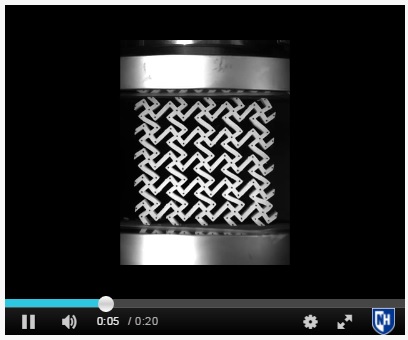UNH sent out a press release about some interesting research on materials – basically alerting the geometry of shapes that are “chiral,” or asymmetric in particular ways, to create lighter protective foams (or, to be specific, chiral auxetic cellular solids). They sent out a video to demonstrate (check it here) – that’s a screen shot shown above.
Material science has always seemed to me like a dull subject – “hey, kids, let’s make better cement!” – but technological changes have increased its importance, especially for 3D printing, and really seem to have livened it up. Yet another fascinating tech topic that I know too little about!
Here’s the full press release:
For the first time, researchers at the University of New Hampshire have shown that rotating cells in chiral cellular solids, a foam-like substance, could lead to the creation of a new smart material. Manipulating the solids by increasing the cell size could lead to safer and lighter weight foam protection in helmets, packaging and armor, and may have biomedical applications in stent designs and drug delivery systems.
“Changing the geometry of the chiral auxetic cellular solids can allow the material to respond differently to certain things like temperature, humidity, light, or impact,” says Yaning Li, assistant professor of mechanical engineering. “For instance, foam in a helmet made of this material could become denser on impact and offer more protection, or a smart medical bandage could be triggered to release medicine based on different levels of swelling.”
In the study, recently published online in Advanced Engineering Materials (3D Printed Chiral Cellular Solids with Amplified Auxetic Effects Due to Elevated Internal Rotation), the researchers outline their approach to alter the behavior of the foam material by changing it on a cellular level. After increasing the rotation of the cells, the researchers used a 3D printer to create a new model that showed an elevated internal efficiency, which allowed it to absorb more energy.
Chiral auxetic cellular solids, or foam, are very flexible in volume change which makes them a good candidate for energy absorption and enhanced protection applications, such as cushioning for helmets, packing materials, and sports or military protective armor. Chiral cellular solids can also be used as a smart facade in buildings, where each cell can open or close automatically when the light intensity or temperature changes during the day to help save energy.
This work has been supported by the National Science Foundation through grants CMMI-1554468 (CAREER), and CMMI-1362893, and DoD/AFOSR through Summer Faculty Fellowship Program (SFFP) and grant FA9550-16-1-0011.


 Return to the Concord Monitor
Return to the Concord Monitor